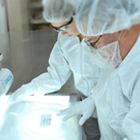Eiwitten en peptiden
Leverancier:
ACROBIOSYSTEMS
Omschrijving:
Human recombinant IL-7-P2A (from HEK293 cells)
Leverancier:
STEMCELL Technologies
Omschrijving:
Interleukin 12 (IL-12p70) is a heterodimeric cytokine composed of p35 and p40 subunits. IL-12 is produced by monocytes, macrophages, dendritic cells, neutrophils, and B cells in response to bacterial products and cytokines such as IFN-γ. The IL-12 receptor is expressed on T, NK, and dendritic cells. Upon binding, IL-12 initiates signaling via the JAK/STAT signaling pathway and stimulates NK, B, and T cells to produce IFN-γ (Watford <i>et al.</i>). It also regulates cytokine synthesis, proliferation of T and NK cells, and stimulates differentiation of CD4+ and CD8+ T cells (Germann and Rüde). Mice that are deficient in IL-12 are susceptible to many intracellular pathogens and have impaired IFN-γ secretion, Th1 differentiation, and NK cytolytic activity; however, Th2 development and IL-4 production are enhanced (Watford <i>et al.</i>).
Leverancier:
STEMCELL Technologies
Omschrijving:
Bone morphogenetic protein 2 (BMP-2) is a member of the transforming growth factor beta (TGF-β) superfamily. BMP-2 is a disulfide-linked homodimer, acts as a ligand for complexes of type I and II BMP receptors, and primarily activates SMAD1/5/8 signaling (Nohe <i>et al.</i>). BMP-2 is a potent differentiation factor and directs human pluripotent stem cells (hPSCs) towards various cell types including extra-embryonic endoderm, mesenchymal cells, and chondrocytes (Pera <i>et al.</i>). Although BMP-2 expression is low in healthy cartilage, its expression is upregulated at the site of cartilage damage (Blaney Davidson <i>et al.</i>). BMP-2 induces bone and cartilage formation in vitro and is able to induce chondrogenesis in human mesenchymal stem cells (Schmitt <i>et al.</i>).
Itemnummer:
(BIRBORB168697-2)
Leverancier:
Biorbyt
Omschrijving:
Mouse recombinant KGF (from <i>E. coli</i>)
UOM:
1 * 2 µG
Itemnummer:
(STMC100-0934)
Leverancier:
STEMCELL Technologies
Omschrijving:
R-Spondin-3 is a member of thrombospondin type 1 repeat (TSR-1) superfamily that is involved in the canonical Wnt/β-catenin signaling pathway (de Lau <i>et al.</i>). R-spondin proteins are characterized by two furin-like repeats at the amino terminus and thrombospondin domain located near the carboxyl terminus (de Lau <i>et al.</i>). R-spondin-3 expression is associated with ovarian cancer (Gu <i>et al.</i>), prostate cancer (Mesci <i>et al.</i>), and differentiation of intestinal epithelial cells in diabetes mellitus (Shan <i>et al.</i>). In a transgenic mice model, the expression of R-Spondin-3 induces the expansion of Lgr5+ stem cells, Paneth cells, and Lgr4+ cells, promoting the intestinal stem cell compartment (Hilkens <i>et al.</i>). This protein contains a His-residue tag at the carboxyl end of the polypeptide chain.
UOM:
1 * 1 EA
Itemnummer:
(STMC100-0943)
Leverancier:
STEMCELL Technologies
Omschrijving:
Receptor activator of nuclear factor kappa-B ligand (RANKL) is a member of the tumor necrosis factor (TNF) superfamily (Anderson <i>et al.</i>). Cytokines in the TNF superfamily are involved in a variety of long-term cellular activities such as differentiation, proliferation, and cell death (MacEwan). RANKL is a type II homotrimeric transmembrane protein expressed in both a membrane-bound and secreted form (Ikeda <i>et al.</i>). RANKL binds to the receptor activator of nuclear factor kappa-B (RANK). Upon binding to its receptor, RANKL activates the AKT signaling pathway (Moon <i>et al.</i>). Osteoprotegerin (OPG) may also bind RANKL, and this binding competes with RANKL-RANK binding (Lacey <i>et al.</i>). RANKL is involved in osteoclastogenesis (Lacey <i>et al.</i>; Yasuda <i>et al.</i>) and T cell activation (Wong <i>et al.</i>). This product is animal component-free.
UOM:
1 * 1 EA
Itemnummer:
(STMC100-1334)
Leverancier:
STEMCELL Technologies
Omschrijving:
Macrophage inflammatory protein-4 (MIP-4) plays a role in adaptive and innate immune responses, acting as a chemoattractant for T and B lymphocytes, and natural killer cells (Krohn <i>et al.</i>). MIP-4 can also induce immune tolerance through its effects on dendritic cells and macrophages (Azzaoui <i>et al.</i>, Schraufstatter <i>et al.</i>). In breast cancer, MIP-4 has been shown to promote the invasiveness and metastasis of cancer cells in vivo by binding PITPNM3 (Chen <i>et al.</i>).This small cytokine belongs to the chemokine family found only in primates. Based on amino acid sequence, MIP-4 is closely related to MIP-1 alpha (CCL3) and MIP-1 beta (CCL4) (Liang <i>et al.</i>). MIP-4 is produced by antigen-presenting immune cells including dendritic cells, macrophages, and monocytes (Lieshout <i>et al.</i>). For consistency and reproducibility across your applications, macrophage inflammatory protein-4 from STEMCELL comes lyophilised with ≥95% purity, and is verified by LAL analysis to ensure endotoxin levels are ≤1,0 EU/μg protein.
UOM:
1 * 1 EA
New Product
Itemnummer:
(STMC100-1338)
Leverancier:
STEMCELL Technologies
Omschrijving:
A type 1 membrane glycoprotein belonging to the immunoglobulin superfamily, cluster of differentiation 200 (CD200) binds the CD200 receptor (CD200R) that is expressed on the surface of myeloid cells and T cells (Wright <i>et al.</i>), and has been shown to inhibit myeloid cell activity and macrophage cytokine production (Jenmalm <i>et al.</i>). Homologues of CD200 have been identified in viruses and can interact with CD200R to reduce macrophage pro-inflammatory cytokine production (Foster-Cuevas <i>et al.</i>). Studies have shown that the immunosuppressive effects of CD200 can promote acceptance of allogeneic tissue grafts in hosts (Gorczynski <i>et al.</i>), whereas dysregulation of CD200/CD200R can contribute to the development of autoimmune conditions, such as rheumatoid arthritis (Ren <i>et al.</i>). CD200 contains two immunoglobulin-like domains, a V-type domain and a smaller C2-type domain (Hatherley <i>et al.</i>). This protein contains a His-residue tag at the carboxyl end of the polypeptide chain. For consistency and reproducibility across your applications, cluster of differentiation 200 from STEMCELL comes lyophilised with ≥95% purity, and is verified by LAL analysis to ensure endotoxin levels are ≤1,0 EU/μg protein. Human recombinant CD200 at 2 μg/ml can bind human CD200R (His and hFc tag) with a linear range of 5 to 28 ng/ml, as determined by functional ELISA.
UOM:
1 * 1 EA
New Product
Itemnummer:
(STMC100-1325)
Leverancier:
STEMCELL Technologies
Omschrijving:
Use omentin for the maintenance of insulin sensitivity and metabolism, decreasing levels of this adipokine have been associated with obesity, insulin resistance, and diabetes (Tan <i>et al.</i>). Studies have suggested that omentin may have protective effects against atherosclerosis, arterial calcification, and myocardial injury through AMP-activated protein kinase (AMPK) and Akt-dependent mechanisms (Xu <i>et al.</i>, Kataoka <i>et al.</i>). Through regulation of Sirt1-dependent p53 deacetylation, omentin can inhibit proliferation and induce apoptosis in hepatocellular carcinoma cells (Zhang and Zhou). Omentin is mainly produced by visceral adipose tissue, but is also expressed in the small intestine, colon, mesothelial cells, vascular cells, and plasma (Watanabe et al). Protein sequence analysis has shown that omentin comprises 313 amino acids, with a secretory signal sequence and fibrinogen-related domain (Yang <i>et al.</i>). For consistency and reproducibility across your applications, Omentin from STEMCELL comes lyophilised with ≥90% purity, and is verified by LAL analysis to ensure endotoxin levels are ≤5,0 EU/μg protein.
UOM:
1 * 1 EA
New Product
Itemnummer:
(STMC100-1391)
Leverancier:
STEMCELL Technologies
Omschrijving:
Stimulating T cells with EBV (HLA Class I Control) peptide pool releases downstream cytokines and upregulates activation markers, enabling antigen-specific T cells to be detected or isolated for analysis. EBV (HLA Class I Control) Peptide Pool is a lyophilised mixture of 26 peptides from Epstein-Barr virus (EBV), and consists of defined HLA class I-restricted T cell epitopes. Viral peptide pools are useful for a broad range of applications, including vaccine development, immunological research, and diagnostic assay development. For consistency and reproducibility across your applications, CMV peptide pool from STEMCELL has a purity ≥95%.
UOM:
1 * 1 PE
New Product
Itemnummer:
(STMC100-1392)
Leverancier:
STEMCELL Technologies
Omschrijving:
Stimulating T cells with HPV16 (L1) Peptide pool releases downstream cytokines and upregulates activation markers, enabling antigen-specific T cells to be detected or isolated for analysis. HPV16 (L1) Peptide pool is a lyophilised mixture of 124 peptides from major capsid protein L1 of human papillomavirus type 16 (HPV16) consisting of 15-mer peptides with 11-amino-acid overlaps that cover amino acids 1 to 505 on L1. L1 enters the nuclei of host cells via a Kap α2β1-mediated pathway (Nelson <i>et al.</i>). It cooperates with E2, another viral protein, to enhance viral DNA replication (Siddiqa <i>et al.</i>). L1 pentamers can assemble into virus-like particles (Chen <i>et al.</i> 2000; Chen <i>et al.</i> 2001). Viral peptide pools are useful for a broad range of applications, including vaccine development, immunological research, and diagnostic assay development.
UOM:
1 * 1 PE
New Product
Itemnummer:
(STMC100-1387)
Leverancier:
STEMCELL Technologies
Omschrijving:
Stimulating T cells with EBV (EBNA-3B) peptide pool releases downstream cytokines and upregulates activation markers, enabling antigen-specific T cells to be detected or isolated for analysis. EBV (EBNA-3B) Peptide Pool is a lyophilised mixture of 234 peptides from Epstein-Barr nuclear antigen 3B (EBNA-3B) of Epstein-Barr virus (EBV; strain AG876) and consists of 15-mer peptides with 11-amino-acid overlaps that cover amino acids 1 to 946 on EBNA-3B. EBNA-3B is considered non-essential for B cell growth transformation (Chen <i>et al.</i>, 2005; Tomkinson and Kieff), but has been shown to regulate the expression of cellular genes in EBV-infected cells (Chen at al., 2006). Viral peptide pools are useful for a broad range of applications, including vaccine development, immunological research, and diagnostic assay development.
UOM:
1 * 1 PE
New Product
Leverancier:
STEMCELL Technologies
Omschrijving:
Basic fibroblast growth factor (bFGF) is a prototypic member of the fibroblast growth factor family. Cytokines in the FGF family possess broad mitogenic and cell survival activities (Folkman and Klagsbrun; Kimelman and Kirschner) and are involved in a variety of biological processes including cell proliferation, differentiation, survival, and apoptosis (Folkman and Klagsbrun; Klagsbrun; Rifkin and Moscatelli). bFGF has the β-trefoil structure (Ponting and Russell), binds to the four FGF receptor (FGFR) family members, and activates JAK/STAT, PI3K, ERK1/2, and other receptor tyrosine kinase (RTK) signaling pathways. It supports the maintenance of undifferentiated human pluripotent stem cells (Xu <i>et al.</i>; Kang <i>et al.</i>), stimulates human pluripotent stem cells to form neural rosettes (Zhang <i>et al.</i>), and improves proliferation of human mesenchymal stem cells and enhances chondrogenic differentiation (Solchaga <i>et al.</i>). This version of bFGF is the full-length bFGF protein encoded by the human FGF2 gene consisting of 154 amino acid residues. This product is animal component-free.
Leverancier:
STEMCELL Technologies
Omschrijving:
Interleukin 2 (IL-2) is a monomeric cytokine that was originally identified as a T cell growth factor (Gaffen and Liu). It binds to heterotrimeric receptors consisting of CD25, CD122, and CD132. Upon binding, it activates JAK3-, STAT5-, and AKT-dependent signaling pathways, which results in cellular proliferation and survival (Ma <i>et al.</i>). The majority of IL-2 is secreted by activated CD4+ and CD8+ T cells, although B cells and dendritic cells were found to produce IL-2 in small amounts. IL-2 downregulates immune responses to prevent autoimmunity during thymic development, influences the development of CD4+CD25+ regulatory T cells, and affects development of follicular helper T cells. IL-2 also controls inflammation by inhibiting Th17 differentiation (Banchereau <i>et al.</i>). High IL-2 levels in serum are associated with progression of scleroderma, rheumatoid arthritis, and gastric and non-small cell lung cancer, though no known disease can be directly attributed to the lack or excess of IL-2 (Gaffen and Liu).
Itemnummer:
(STMC78108.1)
Leverancier:
STEMCELL Technologies
Omschrijving:
Fibroblast growth factor 21 (FGF-21) is a member of the FGF family. Using β-Klotho as a cofactor, FGF-21 signals through FGF receptor 1c and 4 to activate PI3K and MAPK pathways (Mattila and Härkönen; Kharitonenkov <i>et al.</i>). FGF-21 expression is regulated by tissue-specific peroxisome proliferator-activated receptors (PPARs). Upon PPAR-α stimulation FGF-21 is produced in the liver, and activation of PPAR-γ leads to FGF-21 production in adipose tissue. FGF-21 promotes insulin-independent glucose uptake and lipid accumulation in primary human adipocytes and in mouse 3T3-L1 cells. In pancreatic islets and INS-1 cells it inhibits glucose-mediated glucagon release and stimulates insulin production. FGF-21 does not induce proliferation in immortalized cell lines, unlike other FGFs (Kharitonenkov and Shanafelt). FGF-21 regulates thermogenesis in white and brown adipose tissue, and metabolic processes in cells of pancreatic origin (Kharitonenkov <i>et al.</i>).
UOM:
1 * 1 EA
Bel voor prijs
De voorraad voor dit item is beperkt, maar kan beschikbaar zijn in een kortbijgelegen magazijn. Gelieve te controleren of u bent aangemeld op de site zodat de beschikbare voorraad weergegeven kan worden. Als het
De voorraad voor dit item is beperkt, maar kan beschikbaar zijn in een kortbijgelegen magazijn. Gelieve te controleren of u bent aangemeld op de site zodat de beschikbare voorraad weergegeven kan worden. Als het
Dit product is gemarkeerd als beperkt en kan enkel gekocht worden door goedgekeurde verzendingsaccounts. Als u hulp nodig heeft gelieve dan het VWR-Regelgevend Departement te contacteren via regulatory_affairs@vwr.com.
Bijkomende documentatie kan noodzakelijk zijn voor dit item. Een VWR-verantwoordelijke zal contact opnemen met u indien nodig.
Producten die gemarkeerd zijn met dit symbool werden geblokkeerd door uw organisatie. Gelieve contact op te nemen met uw aankoopafdeling
Het originele artikel is niet langer beschikbaar. Het getoonde alternatief is wel beschikbaar.
Product(en) met dit symbool worden binnenkort niet meer verkocht - verkoop tot het einde voorraad. Alternatieven zijn mogelijk beschikbaar door te zoeken met het VWR artikelnummer dat hierboven wordt vermeld. Neem voor meer informatie contact op met onze Customer Service op 016 385 011.
|
|||||||||
















































